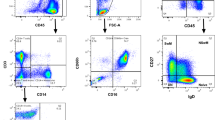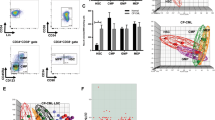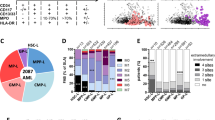Abstract
The cells from approximately 70% patients with acute myeloblastic leukaemia exhibit autonomous growth characteristics in vitro, which have been associated with a poor response to therapy. We have previously shown that leukaemic cells with autonomous growth characteristics express high levels of bcl-2 and are relatively resistant to apoptosis. As bcl-xL is a bcl-2-related gene with anti-apoptotic activity which also confers resistance to cytotoxic drugs we have studied its expression in AML in relation to cellular growth characteristics and to the expression of P-glycoprotein. Cells from 15 patients were studied. Immunoblotting demonstrated bands at 31 kDa corresponding to bcl-xL from the cells of all patients. Bcl-xS was not detected in any sample. Using standardised, quantitative flow cytometry, bcl-xL expression ranged from 0.25 × 105 to 4.24 × 105 bound FITC molecules, (median 1.35 × 105). AML blasts with autonomous growth in vitro expressed more bcl-xL (median 1.76 × 105) than those which did not (median 0.86 × 105, P = 0.01). Quantitative bcl-xL expression strongly correlated with that of P-glycoprotein, also measured by quantitative flow cytometry using the MRK16 antibody (r = 0.95, P < 0.001), but not with mrpr1. these results provide a further explanation for the poor prognosis associated with autonomous in vitro growth of AML blasts and illustrate that these cells may co-express different modalities of resistance to cytotoxic drug therapy involving both anti-apoptotic pathways (bcl-xL, bcl-2) and classic multidrug resistance (MDR1). The implication of these findings is that the use of agents to reverse MDR1 function in AML may be unsuccessful in the absence of strategies to reduce resistance to apoptosis.
This is a preview of subscription content, access via your institution
Access options
Subscribe to this journal
Receive 12 print issues and online access
$259.00 per year
only $21.58 per issue
Buy this article
- Purchase on Springer Link
- Instant access to full article PDF
Prices may be subject to local taxes which are calculated during checkout
Similar content being viewed by others
Author information
Authors and Affiliations
Rights and permissions
About this article
Cite this article
Pallis, M., Zhu, YM. & Russell, N. Bcl-xL is heterogeneously expressed by acute myeloblastic leukaemia cells and is associated with autonomous growth in vitro and with P-glycoprotein expression. Leukemia 11, 945–949 (1997). https://doi.org/10.1038/sj.leu.2400705
Received:
Accepted:
Issue Date:
DOI: https://doi.org/10.1038/sj.leu.2400705
Keywords
This article is cited by
-
The application of BH3 mimetics in myeloid leukemias
Cell Death & Disease (2021)
-
Polymeric delivery of siRNA for dual silencing of Mcl-1 and P-glycoprotein and apoptosis induction in drug-resistant breast cancer cells
Cancer Gene Therapy (2013)
-
Distinct promoters mediate constitutive and inducible Bcl-XL expression in malignant lymphocytes
Oncogene (2007)
-
Recent advances in the development of anticancer agents targeting cell death inhibitors in the Bcl-2 protein family
Leukemia (2003)
-
Induction of chemoresistance in HL-60 cells concomitantly causes a resistance to apoptosis and the synthesis of P-glycoprotein
Leukemia (2001)



